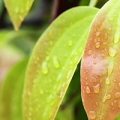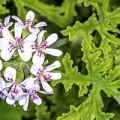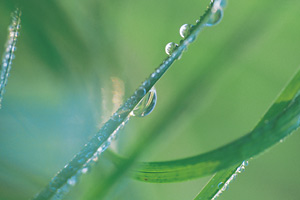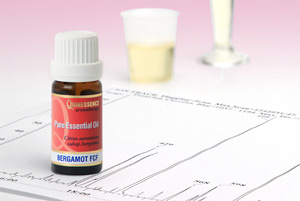Vetiver Essential Oil – The Oil Of Tranquility
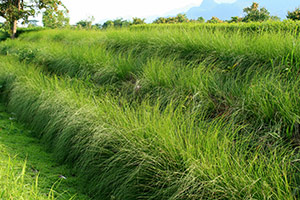 Vetiver essential oil is extracted from the roots of a grass known botanically as Vetiveria zizanoides.
Vetiver essential oil is extracted from the roots of a grass known botanically as Vetiveria zizanoides.
In its natural state as a plant, vetiver has been appreciated for its diverse range of useful applications since records began. In fact, in some countries such as India its role as a perfume may even precede that of the ubiquitous rose.
It has the unusual accolade of being both economically and ecologically important, which makes it one of the most versatile and exciting crops of today. Its uses are not just limited to extracting the distinctive essential oil; the plant is used as a hedgerow barrier to control soil erosion and to stabilize crumbling rural roads, rivers and reservoirs, plus vetiver roots and grass are used to manufacture a vast range of handicrafts products.
Although its aroma is not to everyone’s taste, it does have a unique fragrance that lends itself to a wide range of uses when used at the correct dilution. Perhaps this is why vetiver essential oil has been slowly increasing in popularity since aromatherapy re-emerged in the 1980’s.
Physical description
Vetiveria zizanoides is a dense, erect, clumping perennial grass that grows throughout tropical regions. When growing in the wild, the straight-stemmed, robust leaves easily reach a height of 2 or 3 metres (6ft 6ins – 9ft 9ins) and the plant readily adapts to a wide range of soil and climatic conditions. The plant belongs to the same botanical family as lemongrass, citronella and palmarosa.
In northern India wild vetiver bears purplish or grey-green spikelets which usually grow in pairs, but in southern India and most other countries the non-flowering type is cultivated for the essential oil. Unusually, this plant has a root structure that penetrates down vertically rather than spreading horizontally like most grasses.
Originally native to India, vetiver is now cultivated for the extraction of essential oil in Angola, Argentina, Brazil, China, Haiti, Japan, Java and the island of Réunion. Very little vetiver essential oil is exported from India due to the high demand within the country, where it is used extensively for incense, soaps and toiletries etc.
Traditional uses
Since ancient times in India, the versatile qualities of vetiver roots have been employed in a diverse range of household applications, and this practice is still expanding today. Dried roots are woven into sandals, mats, screens, window blinds, hand fans and ornamental baskets, plus aromatic sachets are used to fragrance bed linen and clothing garments.
Vetiver has been used since time immemorial in Ayurvedic medicine where it is considered to be antitoxic, astringent, bitter and cooling, and was used for bilious fevers and sweats, blood diseases, foul breath, headaches, infections, urinary ulcers, an antidote to poisoning as well as to strengthen the central nervous system and overcome depression, insomnia, anxiety and stress.
According to ancient inscriptions, infused vetiver was used as a perfume by royalty, and the essential oil is still included in an estimated 30% of high-quality modern perfumes to create oriental notes and to act as a fixative.
Harvesting and extraction
Prior to harvesting, the aerial parts of the plant are cut off and collected or sometimes burned back, and then the roots can be lifted either mechanically, or manually using a type of long-handled spade to pry the fibrous roots from the ground. The earth is removed from the roots and they are left to dry for a few days before being washed and cut up, and then distilled on site or transported to the distillery.
Extraction of vetiver essential oil is by steam or water distillation and yields a golden brown to dark brown viscous oil with a rich, sweet, woody-earthy aroma with peppery overtones. The fragrance of vetiver oil is complex and varies tremendously according to the climate and soil it is grown in, the age of the roots, plus the expertise and method used to extract the oil. The essential oil produced in Réunion is known as vetiver Bourbon and is considered the very finest, but commands a much higher price.
Benefits of vetiver essential oil
In India, vetiver is known as the ‘Oil of Tranquility’ due to its relaxing, calming properties on the mind, but it is also strengthening, nurturing and revitalizing to the body. It strengthens connective tissue, restores balance to hormonal and emotional conditions, and regenerates both mind and body. Vetiver is considered a base note in aromatherapy.
Some of these attributes make it a great essential oil to use in skincare, but its powerful aroma can easily dominate a blend if you add too much, so use it judiciously. If you still find the aroma of this oil too strong in your blends, use equal proportions of sandalwood with it to create a softer, warmer base note and a highly beneficial, moisturising action.
Essential oil of vetiver also helps to balance overactive sebaceous glands which make it perfect for drying very oily skin and acne, plus it encourages the production of sebum for dry and mature skin. It also has an impressive healing and rejuvenating action that can be put to good use with wounds, irritated skin, wrinkles and stretch marks. Used in massage it brings relief to arthritis, rheumatism and muscular aches and pains.
Vetiver essential oil is excellent for long term, deep-seated anxiety, depression and stress related conditions. It can be used effectively in baths, massage and diffusers as part of your blends to help ease anxiety and depression. It can often bring stability and strength to those who feel damaged by life’s circumstances and adversities, acting as a ‘grounding’ agent to the weary soul. This oil has the ability to focus the mind and elicit concentration where endurance is required. Personally, I would be totally lost without it!
The sweet woody and earthy fragrance of vetiver essential oil can be tricky to use in blends, but if used sparingly it works really well with benzoin, bergamot, clary sage, geranium, grapefruit, jasmine, lavender, lemongrass, lemon, linaloe wood, neroli, palmarosa, patchouli, petitgrain, rose, sandalwood and ylang ylang.
I often use a combination of vetiver and patchouli essential oils for the main part of the base note in fragrance blends since they work nicely together, and form a solid platform to build the rest of the fragrance on. Lemon notes can work a treat with vetiver and are uplifting for the top end, and petitgrain, neroli, geranium, and lavender all help to balance the heart of the blend.
Browse Quinessence Vetiver Essential Oil
Copyright © Quinessence Aromatherapy Ltd 2021.

